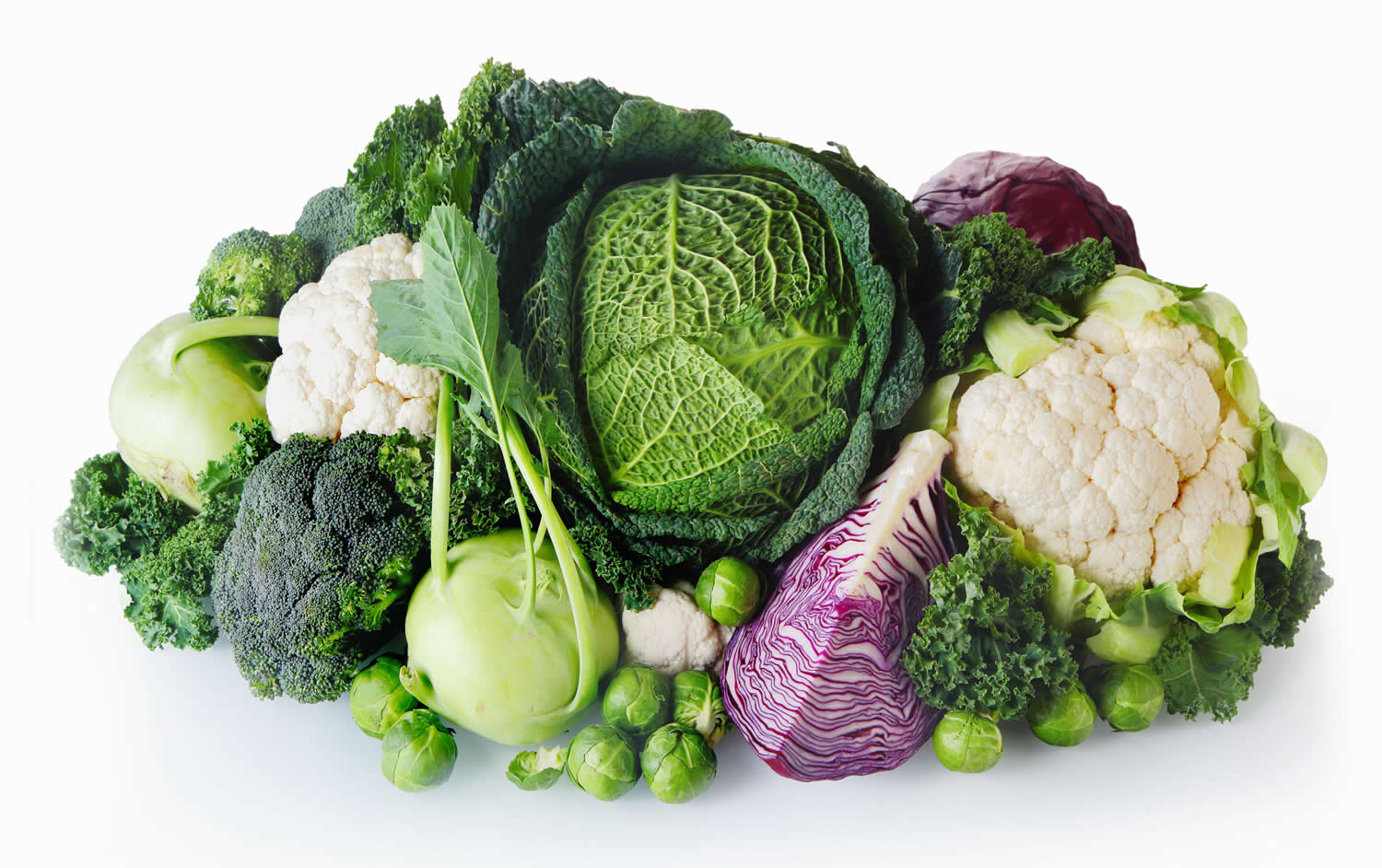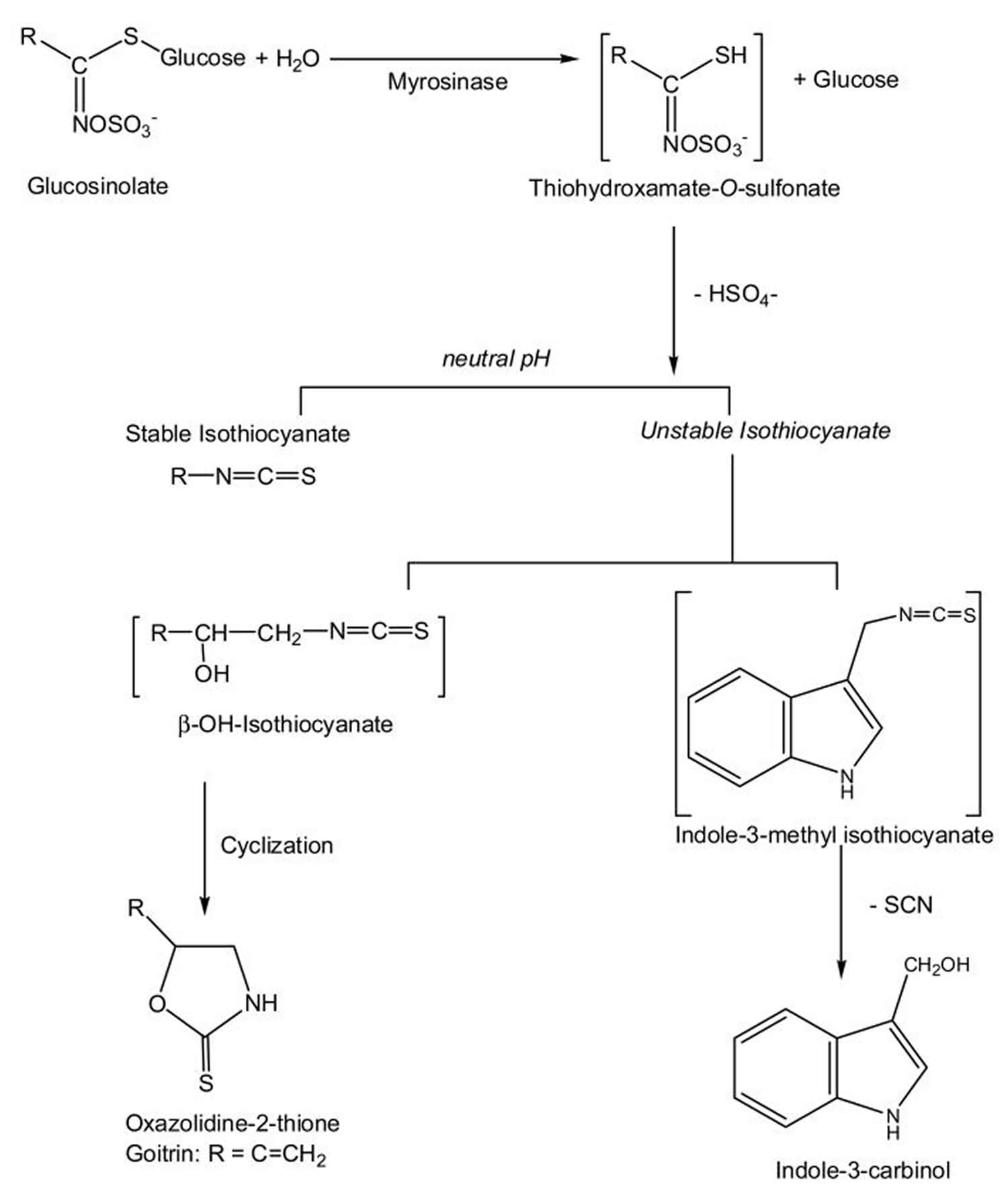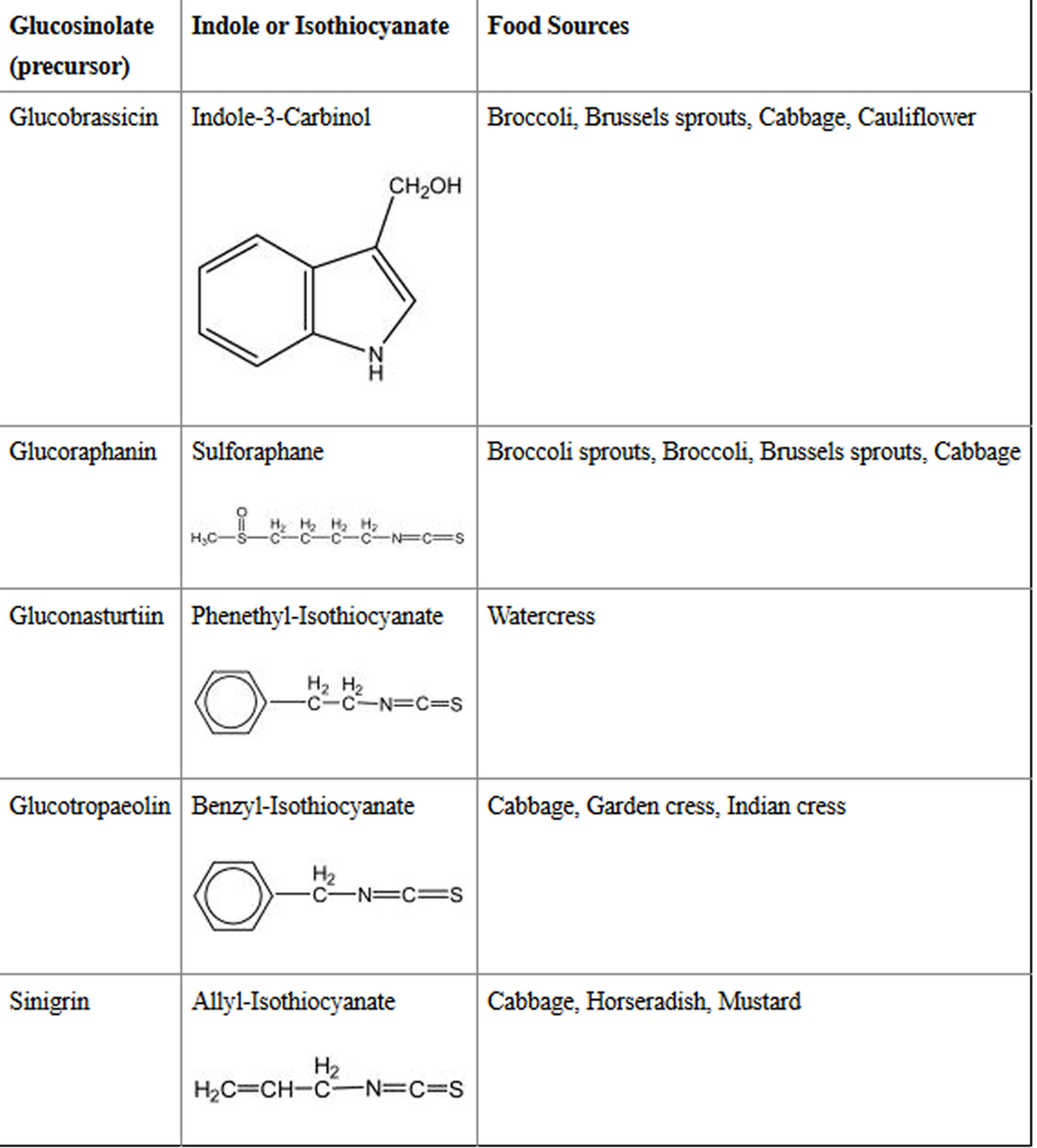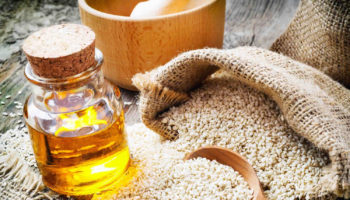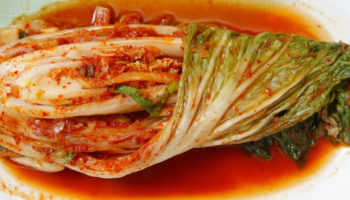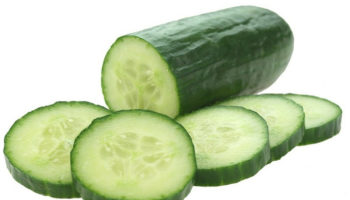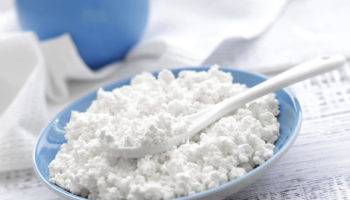What are cruciferous vegetables
Cruciferous vegetables also called Brassica vegetables, is a member of the family of vegetables known to botanists as Cruciferae or alternatively Brassicaceae, that includes broccoli, Brussels sprouts, cabbage, cauliflower, collard greens, kohlrabi, mustard, rutabaga, kale, garden cress, bok choy and turnips 1. Plants in the Cruciferae family have flowers with four equal-sized petals in the shape of a ‘crucifer’ cross. “Brassica” is the latin term for cabbage 2. These vegetables contain substances that may protect against cancer 3.
Like other vegetables, cruciferous vegetables contain a number of nutrients and phytochemicals with cancer chemopreventive properties, including several carotenoids (beta-carotene, lutein, zeaxanthin); vitamins C, E, and K; folate; chlorophyll and minerals. They also are a good fiber source.
In addition, cruciferous vegetables are unique in that they are rich sources of substances known as glucosinolates, which are sulfur-containing chemicals 4. These chemicals are responsible for the pungent aroma and bitter flavor of cruciferous vegetables. The hydrolysis of glucosinolates by the plant enzyme myrosinase results in the formation of biologically active compounds, including indoles and isothiocyanates (Figure 1) 5. More than 100 glucosinolates with unique hydrolysis products have been identified in plants. For example, broccoli is a good source of glucoraphanin, the glucosinolate precursor of sulforaphane and glucobrassicin, the precursor of indole-3-carbinol (I3C) 6. In contrast, watercress is a rich source of gluconasturtiin, the precursor of phenethyl isothiocyanate (PEITC). Table 1 lists some of the isothiocyanates and indoles that are currently under investigation for their cancer chemopreventive properties, along with their glucosinolate precursors.
Figure 1. Breakdown of glucosinolates
[Source 7]Table 1. Some food sources of selected isothiocyanates and their glucosinolate precursors
[Source 2]Cruciferous vegetables are part of a healthy diet. The federal government’s Dietary Guidelines for Americans 8 recommend consuming a variety of vegetables each day. Different vegetables are rich in different nutrients. The intake of cruciferous vegetables is highly variable in different populations 9. Asian and Middle Eastern populations have relatively high intakes (40–80 g/day) as compared with European ones (5.7–32.7 g/day) with an estimate in the Italian population of ∼11.5 g/day 10.
Vegetables are categorized into five subgroups: dark-green, red and orange, beans and peas (legumes), starchy, and other vegetables. Cruciferous vegetables fall into the “dark-green vegetables” category and the “other vegetables” category. More information about vegetables and diet, including how much of these foods should be eaten daily or weekly, is available from the U.S. Department of Agriculture website Choose My Plate 11.
During food preparation, chewing, and digestion, the glucosinolates in cruciferous vegetables are broken down to form biologically active compounds such as indoles, nitriles, thiocyanates, and isothiocyanates 12. Indole-3-carbinol (an indole) and sulforaphane (an isothiocyanate) have been most frequently examined for their anticancer effects.
Indoles and isothiocyanates have been found to inhibit the development of cancer in several organs in rats and mice, including the bladder, breast, colon, liver, lung, and stomach 13. Studies in animals and experiments with cells grown in the laboratory have identified several potential ways in which these compounds may help prevent cancer 14:
- They help protect cells from DNA damage.
- They help inactivate carcinogens.
- They have antiviral and antibacterial effects.
- They have anti-inflammatory effects.
- They induce cell death (apoptosis).
- They inhibit tumor blood vessel formation (angiogenesis) and tumor cell migration (needed for metastasis).
Studies in humans, however, have shown mixed results.
This study 15 confirms that cruciferous vegetables have a beneficial role on the risk of various common cancers, in particular, those of the upper digestive tract, colorectum, breast, and kidney. In that study 15, the inverse association with cruciferous vegetables was stronger in smokers than in nonsmokers in the absence, however, of significant heterogeneity. In a recent intervention study, smokers had a reduction in both endogenous and ex vivo-induced DNA damage following the regular intake of 250 g of steamed broccoli for 10 days, and this effect was particularly evident in subjects with glutathione-S-transferase (GST) M1-null genotype 16. Glutathione-S-transferases (GSTs) are involved in the metabolism of isothiocyanates (ITCs) and may modulate the effect of cruciferous vegetables on cancer risk 17. Other study results by the International Agency for Research on Cancer working group 9 and the results from a few subsequent publications showing that the intestine is among the cancer sites for which the evidence of a beneficial effect of cruciferous vegetables is more convincing 18). Breast cancer has also been reported to be inversely related to cruciferous vegetables 19. Inverse relations for cancers of the oral cavity and esophagus have been reported in a few other (case–control) studies, although data for these neoplasms are limited 20; these cancers, however, have been consistently related to low vegetables consumption 21. Data are even scantier for kidney cancer 22. The absence of an inverse relation with gastric cancer in our data is somewhat in contrast with the results of previous studies suggesting a beneficial effect of cruciferous vegetables, although the issue remains open to discussion 17.
The beneficial effect of cruciferous vegetables on various common cancers may be due to their high content of several antioxidants and vitamins, including carotenoids, polyphenols, vitamin C, and folate 23. Moreover, they contain high levels of glucosinolates, whose major breakdown products (indoles and ITCs) have been shown—in in vitro and animal studies—to have high anticarcinogenic properties, particularly on cancers of the digestive tract, liver, lung, and breast 24. In cultured human cancer cells, ITCs can induce apoptosis and arrest of cell cycle that are critical processes in the prevention of tumor growth 25. Moreover, ITCs seem to inhibit histone deacetylase activity, which removes acetyl groups from histones, thus enabling transcription of tumor suppressor proteins that promote differentiation and apoptosis in precancerous cells 16. ITCs can also affect xenobiotic-metabolizing enzymes that are able to modulate the access of chemical carcinogens to DNA in target tissues 26. In particular, ITCs can modulate expression of phase II enzymes, while indoles act as bifunctional inducers of both phase I and phase II enzymes. This mechanism of action can explain the protection against numerous xenobiotics and carcinogens (e.g. those produced through tobacco smoke or cooked food mutagens), and it was demonstrated also in human colon cancer cell lines following the supplementation with ITCs and indoles where the induction of phase I and phase II enzymes was able to protect cells against benzo[a]pyrene-induced DNA damage 27. Indoles can also decrease estrogen receptor-α expression 28. Through this mechanism, estrogen-dependent signal transduction that results in breast cancer cell proliferation would be decreased, thus providing a molecular basis for the chemopreventive activity against breast cancer.
In summary, this large integrated series of studies provides additional evidence of a favorable effect of cruciferous vegetables on several common cancer sites. Promoting the intake of cruciferous vegetables in populations where consumption is comparably low should be considered 28.
Cruciferous vegetables list
Table 2. List of common cruciferous vegetables
| Common name |
|---|
| Horseradish |
| Land cress |
| Ethiopian mustard |
| Kale |
| Collard greens |
| Chinese broccoli (gai-lan) |
| Cabbage |
| Savoy cabbage |
| Brussels sprouts |
| Kohlrabi |
| Broccoli |
| Broccoflower |
| Broccoli romanesco |
| Cauliflower |
| Wild broccoli |
| Bok choy |
| Komatsuna |
| Mizuna |
| Rapini (broccoli rabe) |
| Choy sum (Flowering cabbage) |
| Chinese cabbage, napa cabbage |
| Turnip root; greens |
| Rutabaga (swede) |
| Siberian kale |
| Canola/rapeseed |
| Wrapped heart mustard cabbage |
| Mustard seeds, brown; greens |
| White mustard seeds |
| Black mustard seeds |
| Tatsoi |
| Wild arugula |
| Arugula (rocket) |
| Field pepperweed |
| Maca |
| Garden cress |
| Watercress |
| Radish |
| Daikon |
| Wasabi |
Cruciferous vegetables benefits
Like most other vegetables, cruciferous vegetables are good sources of a variety of nutrients and phytochemicals that may work synergistically to help prevent cancer 29. One challenge in studying the relationships between cruciferous vegetable intake and cancer risk in humans is separating the benefits of diets that are generally rich in vegetables from those that are specifically rich in cruciferous vegetables 30. An extensive review of epidemiologic studies published prior to 1996 reported that the majority (67%) of 87 case-control studies found an inverse association between some type of cruciferous vegetable intake and cancer risk 31. At that time, the inverse association appeared to be most consistent for cancers of the lung and digestive tract. The results of retrospective case-control studies are more likely to be distorted by bias in the selection of participants (cases and controls) and dietary recall than prospective cohort studies, which collect dietary information from participants before they are diagnosed with cancer 32. In the past decade, results of large prospective cohort studies and studies taking into account individual genetic variation suggest that the relationship between cruciferous vegetable intake and the risk of several types of cancer is more complex than previously thought.
Higher consumption of vegetables in general may protect against some diseases, including some types of cancer. However, when researchers try to distinguish cruciferous vegetables from other foods in the diet, it can be challenging to get clear results because study participants may have trouble remembering precisely what they ate. Also, people who eat cruciferous vegetables may be more likely than people who don’t to have other healthy behaviors that reduce disease risk. It is also possible that some people, because of their genetic background, metabolize dietary isothiocyanates differently. However, research has not yet revealed a specific group of people who, because of their genetics, benefit more than other people from eating cruciferous vegetables.
Researchers have investigated possible associations between intake of cruciferous vegetables and the risk of cancer. The evidence has been reviewed by various experts. Findings for lung, colorectal, breast and prostate cancer, which are the four major causes of cancer-related death in the US, are summarized next,
Prostate cancer
A growing number of epidemiological studies have drawn an association between cruciferous vegetable intake and decreased prostate cancer risk 33, 34. Further epidemiological analysis stratifying specifically on glucosinolate intake (a class of natural compounds produced by crucifers) identified a significant inverse trend with prostate cancer risk 35. Controlled experimentation with glucosinolate derivatives, such as sulforaphane and indole-3-carbinol (I3C), has characterized inhibitory and cytotoxic activity in prostate cancer cells and animal model systems and has provided a mechanistic explanation for how crucifers are causative in lowering cancer risk.
Prostate cancer is the second most commonly diagnosed cancer in men worldwide. Clinical prostate cancer incidence by nation however shows considerable variability. In general, Western nations tend to have a high incidence of prostate cancer, while Asian nations are characterized by a low incidence. In the USA, prostate cancer is predicted to account for 28.5% of all male cancer diagnoses in 2012, affecting over 240,000 men (154 per 100,000) 36, whereas the rate in Asian nations can be up to tenfold lower 37. Diet and lifestyle are thought to be primary contributors to the difference in prostate cancer rates between Western and Asian nations. The proposed influence of diet on prostate cancer rate is supported by studies showing convergence with Western prostate cancer rates in Asian immigrant communities in the USA 38. With regard to cruciferous vegetable intake, Asian nations tend to consume much higher amounts per person than Western nations 39, suggesting that crucifer intake may be an important diet and lifestyle factor contributing to differences in prostate cancer risk.
The cruciferous vegetable family (Brassicaceae) includes many vegetables that are found in the diet—from broccoli, Brussels sprouts, and cauliflower, that are common in the Western diet, to daikon, watercress, and bok choy that are more common in Asian cuisine. Cruciferous vegetables contain a number of glucosinolates whose presence and relative abundance are specific to each species and even to specific cultivars 40. Glucosinolates are the natural plant chemicals (phytochemicals) that give rise to bioactive species. They are cleaved by the endogenous plant enzyme myrosinase to yield active phytochemicals that possess varying degrees of anti-cancer activity. Two phytochemicals that have drawn a significant amount of attention are sulforaphane and I3C. In this review, we will highlight the ability of these phytochemicals to inhibit prostate cancer, focusing on their post-initiation suppressive activity.
Cohort studies in the Netherlands 41, United States 42, and Europe 43 have examined a wide range of daily cruciferous vegetable intakes and found little or no association with prostate cancer risk. However, some case-control studies have found that people who ate greater amounts of cruciferous vegetables had a lower risk of prostate cancer 44.
Colorectal cancer
A small clinical trial found that the consumption of 250 g/d (9 oz/d) of broccoli and 250 g/d of Brussels sprouts significantly increased the urinary excretion of a potential carcinogen found in well-done meat, namely 2-amino-1-methyl-6-phenylimidazo[4,5-b]pyridine (PhIP) 45. Walters et al. 45 concluded that high cruciferous vegetable intake might decrease colorectal cancer risk by enhancing the elimination of PhIP and related dietary heterocyclic amine carcinogens. Although a number of case-control studies conducted prior to 1990 found that people diagnosed with colorectal cancer were more likely to have lower intakes of various cruciferous vegetables than people without colorectal cancer 46, 47, most prospective cohort studies have not found significant inverse associations between cruciferous vegetable intake and the risk of developing colorectal cancer over time 48, 49, 50. Cohort studies in the United States and the Netherlands have generally found no association between cruciferous vegetable intake and colorectal cancer risk 51. One exception was a prospective study of Dutch adults, which found that men and women with the highest intakes of cruciferous vegetables (averaging 58 g/d) were significantly less likely to develop colon cancer than those with the lowest intakes (averaging 11 g/d) 52. Surprisingly, higher intakes of cruciferous vegetables were associated with increased risk of rectal cancer in women in that study 52. As with lung cancer, the relationship between cruciferous vegetable consumption and colorectal cancer risk may be complicated by genetic polymorphisms. The results of several recent epidemiological studies suggest that the protective effects of cruciferous vegetable consumption may be influenced by inherited differences in the capacity of individuals to metabolize and eliminate glucosinolate hydrolysis products 53.
Lung cancer
When evaluating the effect of cruciferous vegetable consumption on lung cancer risk, it is important to remember that the benefit of increasing cruciferous vegetable intake is likely to be small compared to the benefit of smoking cessation 54. Although a number of case-control studies found that people diagnosed with lung cancer had significantly lower intakes of cruciferous vegetables than people in cancer-free control groups 55, the findings of more recent prospective cohort studies have been mixed. Prospective studies of Dutch men and women 56, U.S. analysis—using data from the Nurses’ Health Study and the Health Professionals’ Follow-up Study—showed that women who ate more than 5 servings of cruciferous vegetables per week had a lower risk of lung cancer 57 and Finnish men 58 found that higher intakes of cruciferous vegetables (more than three weekly servings) were associated with significant reductions in lung cancer risk, but prospective studies of U.S. men 59 and European men and women Miller AB, Altenburg HP, Bueno-de-Mesquita B, Boshuizen HC, Agudo A, Berrino F, et al. Fruits and vegetables and lung cancer: findings from the european prospective investigation into cancer and nutrition. Int J Cancer. 2004;108:269–76. found no inverse association. The results of several studies suggest that genetic variation affecting the metabolism of glucosinolate hydrolysis products may influence the effects of cruciferous vegetable consumption on lung cancer risk 60, 61.
Breast cancer
One case-control study found that women who ate greater amounts of cruciferous vegetables had a lower risk of breast cancer 62.
The endogenous estrogen 17β-estradiol can be metabolized to 16α-hydroxyestrone (16αOHE1) or 2-hydroxyestrone (2OHE1). In contrast to 2OHE1, 16αOHE1 is highly estrogenic and has been found to enhance the proliferation of estrogen-sensitive breast cancer cells in culture 63. It has been hypothesized that shifting the metabolism of 17β-estradiol toward 2OHE1 and away from 16αOHE1 could decrease the risk of estrogen-sensitive cancers, such as breast cancer 64. In a small clinical trial, increasing cruciferous vegetable intake of healthy postmenopausal women for four weeks increased urinary 2OHE1:16αOHE1 ratios, suggesting that high intakes of cruciferous vegetables can shift estrogen metabolism. However, the relationship between urinary 2OHE1:16OHE1 ratios and breast cancer risk is not clear. Several small case-control studies found that women with breast cancer had lower urinary ratios of 2OHE1:16αOHE1 65, 66, 67, but larger case-control and prospective cohort studies did not find significant associations between urinary 2OHE1:16αOHE1 ratios and breast cancer risk 68, 69, 70. The results of epidemiological studies of cruciferous vegetable intake and breast cancer risk are also inconsistent. Several recent case-control studies in the US, Sweden and China found that measures of cruciferous vegetable intake were significantly lower in women diagnosed with breast cancer than in cancer-free control groups 71, 72, 73, but cruciferous vegetable intake was not associated with breast cancer risk in a pooled analysis of seven large prospective cohort studies conducted in the United States, Canada, Sweden, and the Netherlands 74. An additional cohort study of women in the United States similarly showed only a weak association with breast cancer risk 75.
A few studies have shown that the bioactive components of cruciferous vegetables can have beneficial effects on biomarkers of cancer-related processes in people. For example, one study found that indole-3-carbinol was more effective than placebo in reducing the growth of abnormal cells on the surface of the cervix 76.
In addition, several case-control studies have shown that specific forms of the gene that encodes glutathione S-transferase, which is the enzyme that metabolizes and helps eliminate isothiocyanates from the body, may influence the association between cruciferous vegetable intake and human lung and colorectal cancer risk 77.
Cruciferous vegetables Adverse effects
In vivo, naturally occurring isothiocyanates and their metabolites have been found to inhibit the development of chemically-induced cancers of the lung, liver, esophagus, stomach, small intestine, colon and mammary gland (breast) in a variety of animal models 78, 79. When administered before or at the same time as the carcinogen, oral indole-3-carbinol (I3C) has been found to inhibit the development of cancer in a variety of animal models and tissues, including cancers of the mammary gland (breast) 80, stomach 81, colon 82, lung 83 and liver 84. However, a number of studies found that I3C actually promoted or enhanced the development of cancer when administered chronically after the carcinogen (post initiation). The cancer promoting effects of I3C were first reported in a trout model of liver cancer 85. However, I3C also has been found to promote or enhance cancer of the liver 86, thyroid 87, colon 88 and uterus 89 in rats. The long-term effects of I3C supplementation on cancer risk in humans are not known, but the contradictory results of animal studies have led some to caution against the widespread use of indole-3-carbinol (I3C) and dimer 3,3′-diindolylmethane (DIM) supplements in humans until the potential risks versus benefits are better understood 90, 91.
References- Brassica vegetables and prostate cancer risk: a review of the epidemiological evidence. Kristal AR, Lampe JW. Nutr Cancer. 2002; 42(1):1-9. https://www.ncbi.nlm.nih.gov/pubmed/12235639/
- Higdon JV, Delage B, Williams DE, Dashwood RH. Cruciferous Vegetables and Human Cancer Risk: Epidemiologic Evidence and Mechanistic Basis. Pharmacological research : the official journal of the Italian Pharmacological Society. 2007;55(3):224-236. doi:10.1016/j.phrs.2007.01.009. https://www.ncbi.nlm.nih.gov/pmc/articles/PMC2737735/
- https://www.cancer.gov/publications/dictionaries/cancer-terms?cdrid=44963
- Bitter taste, phytonutrients, and the consumer: a review. Drewnowski A, Gomez-Carneros C. Am J Clin Nutr. 2000 Dec; 72(6):1424-35.
- A critical review of the bioavailability of glucosinolates and related compounds. Holst B, Williamson G. Nat Prod Rep. 2004 Jun; 21(3):425-47. https://www.ncbi.nlm.nih.gov/pubmed/15162227/
- Cancer-preventive isothiocyanates: measurement of human exposure and mechanism of action. Zhang Y. Mutat Res. 2004 Nov 2; 555(1-2):173-90. https://www.ncbi.nlm.nih.gov/pubmed/15476859/
- A critical review of the bioavailability of glucosinolates and related compounds. Holst B, Williamson G. Nat Prod Rep. 2004 Jun; 21(3):425-47. http://pubs.rsc.org/en/Content/ArticleLanding/2004/NP/b204039p
- Dietary Guidelines for Americans. https://health.gov/dietaryguidelines/
- IARC, IARC Handbooks of Cancer Prevention. Volume 9. Cruciferous Vegetables, Isothiocyanates and Indoles , 2004Lyon, FranceIARC Press
- Bosetti C, Negri E, Kolonel L, et al. A pooled analysis of case-control studies of thyroid cancer. VII. Cruciferous and other vegetables (International), Cancer Causes Control , 2002, vol. 13; pg. 765-775.
- ChooseMyPlate. https://www.choosemyplate.gov/
- Hayes JD, Kelleher MO, Eggleston IM. The cancer chemopreventive actions of phytochemicals derived from glucosinolates. European Journal of Nutrition 2008;47 Suppl 2:73-88.
- Murillo G, Mehta RG. Cruciferous vegetables and cancer prevention. Nutrition and Cancer 2001;41(1-2):17-28.
- Cruciferous Vegetables and Cancer Prevention. https://www.cancer.gov/about-cancer/causes-prevention/risk/diet/cruciferous-vegetables-fact-sheet
- C. Bosetti, M. Filomeno, P. Riso, J. Polesel, F. Levi, R. Talamini, M. Montella, E. Negri, S. Franceschi, C. La Vecchia; Cruciferous vegetables and cancer risk in a network of case–control studies, Annals of Oncology, Volume 23, Issue 8, 1 August 2012, Pages 2198–2203, https://doi.org/10.1093/annonc/mdr604
- Riso P, Martini D, Moller P, et al. DNA damage and repair activity after broccoli intake in young healthy smokers, Mutagenesis , 2010, vol. 25;pg. 595-602.
- Kim MK, Park JH. Conference on “Multidisciplinary approaches to nutritional problems”. Symposium on “Nutrition and health”. Cruciferous vegetable intake and the risk of human cancer: epidemiological evidence, Proc Nutr Soc , 2009, vol. 68; pg. 103-110.
- Yang G, Gao YT, Shu XO, et al. Isothiocyanate exposure, glutathione S-transferase polymorphisms, and colorectal cancer risk, Am J Clin Nutr , 2010, vol. 91 (pg. 704-711
- Lee SA, Fowke JH, Lu W, et al. Cruciferous vegetables, the GSTP1 Ile105Val genetic polymorphism, and breast cancer risk, Am J Clin Nutr , 2008, vol. 87;pg. 753-760
- Fowke JH. Head and neck cancer: a case for inhibition by isothiocyanates and indoles from cruciferous vegetables, Eur J Cancer Prev , 2007, vol. 16; pg. 348-356.
- World Cancer Research Fund and American Institute for Cancer Research, Food, Nutrition, Physical Activity and the Prevention of Cancer: a Global Perspective , 2007Washington, DCAICR
- Moore LE, Brennan P, Karami S, et al. Glutathione S-transferase polymorphisms, cruciferous vegetable intake and cancer risk in the Central and Eastern European Kidney Cancer Study, Carcinogenesis , 2007, vol. 28; pg. 1960-1964.
- Higdon JV, Delage B, Williams DE, Dashwood RH. Cruciferous vegetables and human cancer risk: epidemiologic evidence and mechanistic basis, Pharm Res , 2007, vol. 55,pg. 224-236.
- Bonnesen C, Eggleston IM, Hayes JD. Dietary indoles and isothiocyanates that are generated from cruciferous vegetables can both stimulate apoptosis and confer protection against DNA damage in human colon cell lines, Cancer Res , 2001, vol. 61,pg. 6120-6130.
- Verhoeven DT, Verhagen H, Goldbohm RA, et al. A review of mechanisms underlying anticarcinogenicity by brassica vegetables, Chem Biol Interact , 1997, vol. 103;pg. 79-129.
- Pelucchi C, Bosetti C, Rossi M, et al. Selected aspects of Mediterranean diet and cancer risk, Nutr Cancer , 2009, vol. 61;pg. 756-766.
- Bonnesen C, Eggleston IM, Hayes JD. Dietary indoles and isothiocyanates that are generated from cruciferous vegetables can both stimulate apoptosis and confer protection against DNA damage in human colon cell lines, Cancer Res , 2001, vol. 61; pg. 6120-6130.
- Bosetti C, Negri E, Kolonel L, et al. A pooled analysis of case-control studies of thyroid cancer. VII. Cruciferous and other vegetables (International), Cancer Causes Control , 2002, vol. 13;pg. 765-775.
- Liu RH. Potential synergy of phytochemicals in cancer prevention: mechanism of action. J Nutr. 2004;134:3479S–85S.
- McNaughton SA, Marks GC. Development of a food composition database for the estimation of dietary intakes of glucosinolates, the biologically active constituents of cruciferous vegetables. Br J Nutr. 2003;90:687–97.
- Verhoeven DT, Goldbohm RA, van Poppel G, Verhagen H, van den Brandt PA. Epidemiological studies on brassica vegetables and cancer risk. Cancer Epidemiol Biomarkers Prev. 1996;5:733–48. http://cebp.aacrjournals.org/content/5/9/733.long
- Willett W. Oxford University Press; New York: 1998. pp. 148–56.
- Richman EL, Carroll PR, Chan JM. Vegetable and fruit intake after diagnosis and risk of prostate cancer progression. Int J Cancer. 2011;131(1):201–210. doi: 10.1002/ijc.26348.
- Liu B, Mao Q, Cao M, Xie L. Cruciferous vegetables intake and risk of prostate cancer: a meta-analysis. Int J Urol. 2012;19(2):134–141. doi: 10.1111/j.1442-2042.2011.02906.x.
- Steinbrecher A, Nimptsch K, Husing A, Rohrmann S, Linseisen J. Dietary glucosinolate intake and risk of prostate cancer in the EPIC-Heidelberg cohort study. Int J Cancer. 2009;125(9):2179–2186. doi: 10.1002/ijc.24555.
- Howlader N, Noone AM, Krapcho M, Neyman N, Aminou R, Altekruse SF, et al., editors. SEER Cancer Statistics Review, 1975–2009 (Vintage 2009 Populations). 2012.
- Ferlay J, Shin HR, Bray F, Forman D, Mathers C, Parkin DM. GLOBOCAN 2008 v2.0, Cancer Incidence and Mortality Worldwide: IARC CancerBase No. 10 (Internet). International Agency for Research on Cancer. 2010. Available from: http://globocan.iarc.fr
- Lee J, Demissie K, Lu SE, Rhoads GG. Cancer incidence among Korean-American immigrants in the United States and native Koreans in South Korea. Cancer Control. 2007;14(1):78–85.
- IARC, IARC Handbooks of Cancer Prevention. Volume 9. Cruciferous Vegetables, Isothiocyanates and Indoles, 2004. Lyon, France IARC Press
- McNaughton SA, Marks GC. Development of a food composition database for the estimation of dietary intakes of glucosinolates, the biologically active constituents of cruciferous vegetables. Br J Nutr. 2003;90(3):687–697. doi: 10.1079/BJN2003917.
- Schuurman AG, Goldbohm RA, Dorant E, van den Brandt PA. Vegetable and fruit consumption and prostate cancer risk: a cohort study in The Netherlands. Cancer Epidemiology, Biomarkers & Prevention 1998;7(8):673-680.
- Giovannucci E, Rimm EB, Liu Y, Stampfer MJ, Willett WC. A prospective study of cruciferous vegetables and prostate cancer. Cancer Epidemiology, Biomarkers & Prevention 2003;12(12):1403-1409.
- Key TJ, Allen N, Appleby P, et al. Fruits and vegetables and prostate cancer: no association among 1104 cases in a prospective study of 130544 men in the European Prospective Investigation into Cancer and Nutrition (EPIC). International Journal of Cancer 2004;109(1):119-124.
- Kolonel LN, Hankin JH, Whittemore AS, et al. Vegetables, fruits, legumes and prostate cancer: a multiethnic case-control study. Cancer Epidemiology, Biomarkers & Prevention 2000;9(8):795-804.
- Walters DG, Young PJ, Agus C, Knize MG, Boobis AR, Gooderham NJ, et al. Cruciferous vegetable consumption alters the metabolism of the dietary carcinogen 2-amino-1-methyl-6-phenylimidazo[4,5-b]pyridine (PhIP) in humans. Carcinogenesis. 2004;25:1659–69.
- Benito E, Obrador A, Stiggelbout A, Bosch FX, Mulet M, Munoz N, et al. A population-based case-control study of colorectal cancer in Majorca. I. Dietary factors. Int J Cancer. 1990;45:69–76.
- West DW, Slattery ML, Robison LM, Schuman KL, Ford MH, Mahoney AW, et al. Dietary intake and colon cancer: sex- and anatomic site-specific associations. Am J Epidemiol. 1989;130:883–94.
- Kojima M, Wakai K, Tamakoshi K, Tokudome S, Toyoshima H, Watanabe Y, et al. Diet and colorectal cancer mortality: results from the Japan Collaborative Cohort Study. Nutr Cancer. 2004;50:23–32.
- McCullough ML, Robertson AS, Chao A, Jacobs EJ, Stampfer MJ, Jacobs DR, et al. A prospective study of whole grains, fruits, vegetables and colon cancer risk. Cancer Causes Control. 2003;14:959–70.
- Michels KB, Edward G, Joshipura KJ, Rosner BA, Stampfer MJ, Fuchs CS, et al. Prospective study of fruit and vegetable consumption and incidence of colon and rectal cancers. J Natl Cancer Inst. 2000;92:1740–52.
- McCullough ML, Robertson AS, Chao A, et al. A prospective study of whole grains, fruits, vegetables and colon cancer risk. Cancer Causes & Control 2003;14(10):959-970.
- Voorrips LE, Goldbohm RA, van Poppel G, Sturmans F, Hermus RJ, van den Brandt PA. Vegetable and fruit consumption and risks of colon and rectal cancer in a prospective cohort study: The Netherlands Cohort Study on Diet and Cancer. Am J Epidemiol. 2000;152:1081–92.https://www.ncbi.nlm.nih.gov/pubmed/11117618
- Turner F, Smith G, Sachse C, Lightfoot T, Garner RC, Wolf CR, et al. Vegetable, fruit and meat consumption and potential risk modifying genes in relation to colorectal cancer. Int J Cancer. 2004;112:259–64.
- Miller AB, Altenburg HP, Bueno-de-Mesquita B, Boshuizen HC, Agudo A, Berrino F, et al. Fruits and vegetables and lung cancer: findings from the european prospective investigation into cancer and nutrition. Int J Cancer. 2004;108:269–76.
- Verhoeven DT, Goldbohm RA, van Poppel G, Verhagen H, van den Brandt PA. Epidemiological studies on brassica vegetables and cancer risk. Cancer Epidemiol Biomarkers Prev. 1996;5:733–48.
- Voorrips LE, Goldbohm RA, Verhoeven DT, van Poppel GA, Sturmans F, Hermus RJ, et al. Vegetable and fruit consumption and lung cancer risk in the Netherlands Cohort Study on diet and cancer. Cancer Causes Control. 2000;11:101–15.
- Feskanich D, Ziegler RG, Michaud DS, et al. Prospective study of fruit and vegetable consumption and risk of lung cancer among men and women. Journal of the National Cancer Institute 2000;92(22):1812-1823.
- Neuhouser ML, Patterson RE, Thornquist MD, Omenn GS, King IB, Goodman GE. Fruits and vegetables are associated with lower lung cancer risk only in the placebo arm of the beta-carotene and retinol efficacy trial (CARET) Cancer Epidemiol Biomarkers Prev. 2003;12:350–8.
- Feskanich D, Ziegler RG, Michaud DS, Giovannucci EL, Speizer FE, Willett WC, et al. Prospective study of fruit and vegetable consumption and risk of lung cancer among men and women. J Natl Cancer Inst. 2000;92:1812–23.
- Zhao B, Seow A, Lee EJ, Poh WT, Teh M, Eng P, et al. Dietary isothiocyanates, glutathione S-transferase -M1, -T1 polymorphisms and lung cancer risk among Chinese women in Singapore. Cancer Epidemiol Biomarkers Prev. 2001;10:1063–7.
- London SJ, Yuan JM, Chung FL, Gao YT, Coetzee GA, Ross RK, et al. Isothiocyanates, glutathione S-transferase M1 and T1 polymorphisms, and lung-cancer risk: a prospective study of men in Shanghai, China. Lancet. 2000;356:724–9.
- Terry P, Wolk A, Persson I, Magnusson C. Brassica vegetables and breast cancer risk. JAMA 2001;285(23):2975-2977.
- Yuan F, Chen DZ, Liu K, Sepkovic DW, Bradlow HL, Auborn K. Anti-estrogenic activities of indole-3-carbinol in cervical cells: implication for prevention of cervical cancer. Anticancer Res. 1999;19:1673–80.
- Bradlow HL, Telang NT, Sepkovic DW, Osborne MP. 2-hydroxyestrone: the ‘good’ estrogen. J Endocrinol. 1996;150 Suppl:S259–65.
- Ho GH, Luo XW, Ji CY, Foo SC, Ng EH. Urinary 2/16 alpha-hydroxyestrone ratio: correlation with serum insulin-like growth factor binding protein-3 and a potential biomarker of breast cancer risk. Ann Acad Med Singapore. 1998;27:294–9.
- Kabat GC, Chang CJ, Sparano JA, Sepkovie DW, Hu XP, Khalil A, et al. Urinary estrogen metabolites and breast cancer: a case-control study. Cancer Epidemiol Biomarkers Prev. 1997;6:505–9.
- Schneider J, Kinne D, Fracchia A, Pierce V, Anderson KE, Bradlow HL, et al. Abnormal oxidative metabolism of estradiol in women with breast cancer. Proc Natl Acad Sci USA. 1982;79:3047–51.
- Cauley JA, Zmuda JM, Danielson ME, Ljung BM, Bauer DC, Cummings SR, et al. Estrogen metabolites and the risk of breast cancer in older women. Epidemiology. 2003;14:740–4.
- Meilahn EN, De Stavola B, Allen DS, Fentiman I, Bradlow HL, Sepkovic DW, et al. Do urinary oestrogen metabolites predict breast cancer? Guernsey III cohort follow-up Br J Cancer. 1998;78:1250–5.
- Ursin G, London S, Stanczyk FZ, Gentzschein E, Paganini-Hill A, Ross RK, et al. Urinary 2-hydroxyestrone/16alpha-hydroxyestrone ratio and risk of breast cancer in postmenopausal women. J Natl Cancer Inst. 1999;91:1067–72.
- Ambrosone CB, McCann SE, Freudenheim JL, Marshall JR, Zhang Y, Shields PG. Breast cancer risk in premenopausal women is inversely associated with consumption of broccoli, a source of isothiocyanates, but is not modified by GST genotype. J Nutr. 2004;134:1134–8.
- Fowke JH, Chung FL, Jin F, Qi D, Cai Q, Conaway C, et al. Urinary isothiocyanate levels, brassica, and human breast cancer. Cancer Res. 2003;63:3980–6.
- Terry P, Wolk A, Persson I, Magnusson C. Brassica vegetables and breast cancer risk. JAMA. 2001;285:2975–7.
- Smith-Warner SA, Spiegelman D, Yaun SS, Adami HO, Beeson WL, van den Brandt PA, et al. Intake of fruits and vegetables and risk of breast cancer: a pooled analysis of cohort studies. JAMA. 2001;285:769–76.
- Zhang S, Hunter DJ, Forman MR, et al. Dietary carotenoids and vitamins A, C, and E and risk of breast cancer. Journal of the National Cancer Institute 1999;91(6):547-556.
- Bell MC, Crowley-Nowick P, Bradlow HL, et al. Placebo-controlled trial of indole-3-carbinol in the treatment of CIN. Gynecologic Oncology 2000;78(2):123-129.
- Yang G, Gao YT, Shu XO, et al. Isothiocyanate exposure, glutathione S-transferase polymorphisms, and colorectal cancer risk. American Journal of Clinical Nutrition 2010;91(3):704-711.
- Hecht SS, Carmella SG, Kenney PM, Low SH, Arakawa K, Yu MC. Effects of cruciferous vegetable consumption on urinary metabolites of the tobacco-specific lung carcinogen 4-(methylnitrosamino)-1-(3-pyridyl)-1-butanone in Singapore Chinese. Cancer Epidemiol Biomarkers Prev. 2004;13:997–1004.
- Conaway CC, Yang YM, Chung FL. Isothiocyanates as cancer chemopreventive agents: their biological activities and metabolism in rodents and humans. Curr Drug Metab. 2002;3:233–55.
- Grubbs CJ, Steele VE, Casebolt T, Juliana MM, Eto I, Whitaker LM, et al. Chemoprevention of chemically-induced mammary carcinogenesis by indole-3-carbinol. Anticancer Res. 1995;15:709–16.
- Wattenberg LW, Loub WD. Inhibition of polycyclic aromatic hydrocarbon-induced neoplasia by naturally occurring indoles. Cancer Res. 1978;38:1410–3.
- Wargovich MJ, Chen CD, Jimenez A, Steele VE, Velasco M, Stephens LC, et al. Aberrant crypts as a biomarker for colon cancer: evaluation of potential chemopreventive agents in the rat. Cancer Epidemiol Biomarkers Prev. 1996;5:355–60.
- Morse MA, LaGreca SD, Amin SG, Chung FL. Effects of indole-3-carbinol on lung tumorigenesis and DNA methylation induced by 4-(methylnitrosamino)-1-(3-pyridyl)-1-butanone (NNK) and on the metabolism and disposition of NNK in A/J mice. Cancer Res. 1990;50:2613–7.
- Dashwood RH, Arbogast DN, Fong AT, Hendricks JD, Bailey GS. Mechanisms of anti-carcinogenesis by indole-3-carbinol: detailed in vivo DNA binding dose-response studies after dietary administration with aflatoxin B1. Carcinogenesis. 1988;9:427–32.
- Oganesian A, Hendricks JD, Pereira CB, Orner GA, Bailey GS, Williams DE. Potency of dietary indole-3-carbinol as a promoter of aflatoxin B1-initiated hepatocarcinogenesis: results from a 9000 animal tumor study. Carcinogenesis. 1999;20:453–8.
- Stoner G, Casto B, Ralston S, Roebuck B, Pereira C, Bailey G. Development of a multi-organ rat model for evaluating chemopreventive agents: efficacy of indole-3-carbinol. Carcinogenesis. 2002;23:265–72.
- Kim DJ, Han BS, Ahn B, Hasegawa R, Shirai T, Ito N, et al. Enhancement by indole-3-carbinol of liver and thyroid gland neoplastic development in a rat medium-term multiorgan carcinogenesis model. Carcinogenesis. 1997;18:377–81.
- Pence BC, Buddingh F, Yang SP. Multiple dietary factors in the enhancement of dimethylhydrazine carcinogenesis: main effect of indole-3-carbinol. J Natl Cancer Inst. 1986;77:269–76.
- Yoshida M, Katashima S, Ando J, Tanaka T, Uematsu F, Nakae D, et al. Dietary indole-3-carbinol promotes endometrial adenocarcinoma development in rats initiated with N-ethyl-N′-nitro-N-nitrosoguanidine, with induction of cytochrome P450s in the liver and consequent modulation of estrogen metabolism. Carcinogenesis. 2004;25:2257–64.
- Dashwood RH. Indole-3-carbinol: anticarcinogen or tumor promoter in brassica vegetables? Chem Biol Interact. 1998;110:1–5. https://www.ncbi.nlm.nih.gov/pubmed/9566721
- Lee BM, Park KK. Beneficial and adverse effects of chemopreventive agents. Mutat Res. 2003;523–524:265–78. https://www.ncbi.nlm.nih.gov/pubmed/12628524
